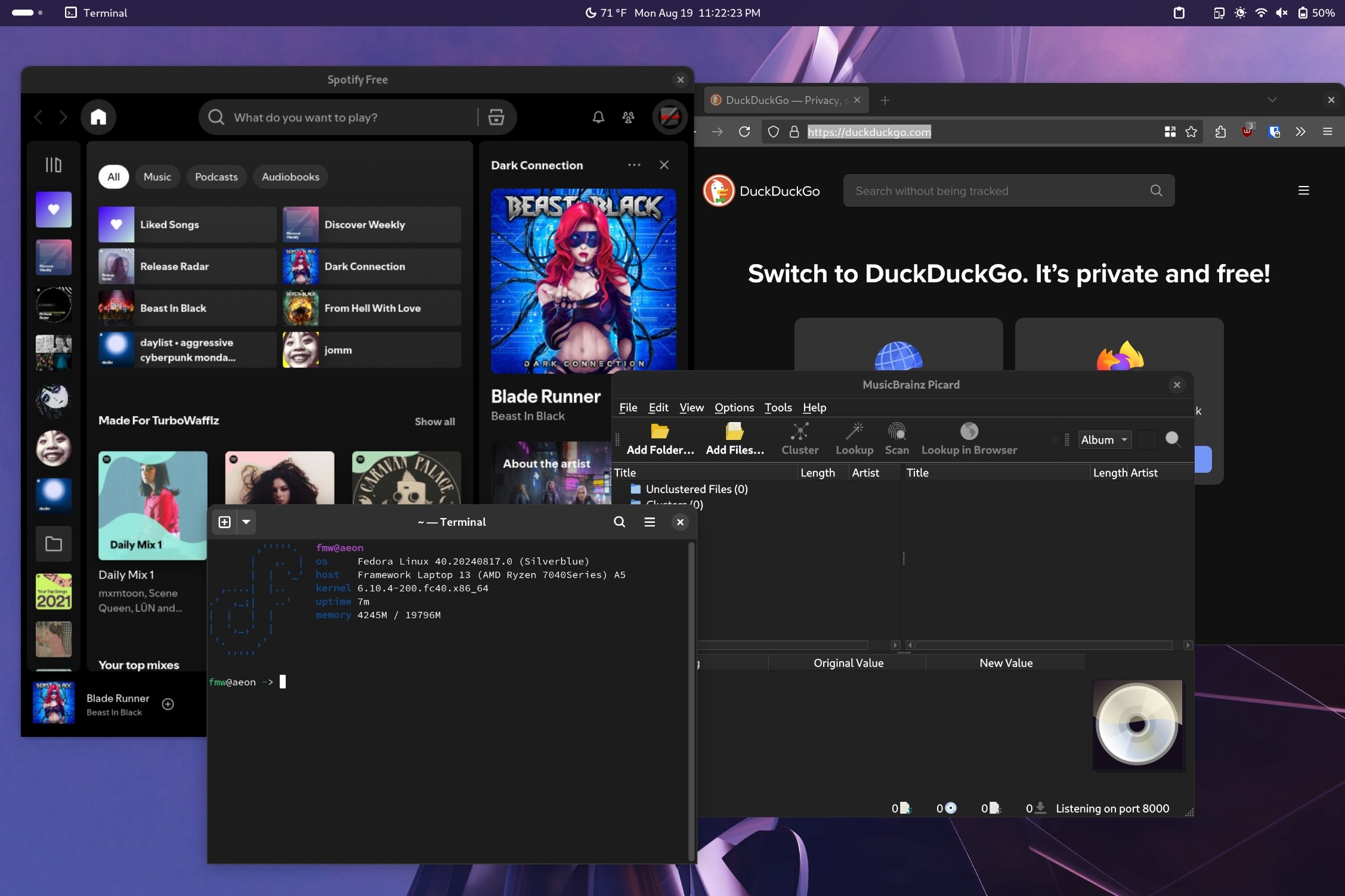Wuuttup. I’m here complaining again about Framework’s Linux unfriendly display. The new one this time.
https://frame.work/products/display-kit?v=FRANJF0001
Old display, 2256 x 1504 (3:2)
GNOME
100% scale
- Nothing looks blurry
- Everything is tiny
- Unusable
100% scale + large text accessibility
- Nothing looks blurry
- Most apps scale appropriately
- Some apps don’t respect GNOME’s large text setting (Alacritty)
125% scale
- Most apps look blurry (Picard, Firefox, Spotify, Alacritty)
200% scale
- Everything is way too big
- Unusable
Plasma
100% scale
- Nothing looks blurry
- Everything is tiny
- Unusable
125% scale + Apply scaling themselves
- Nothing looks blurry
- Most apps scale appropriate
- Some apps can’t scale themselves and look tiny (Picard)
125% scale + Scaled by system
- Most apps look blurry (Picard, Firefox, Spotify, Alacritty)
200% scale
- Everything is way too big
- Unusable
New display, 2880 x 1920 (3:2)
GNOME
100% scale
- Nothing looks blurry
- Everything is tiny
- Unusable
100% scale + large text accessibility
- Nothing looks blurry
- Most apps scale appropriately
- Some apps don’t respect GNOME’s large text setting (Alacritty)
- Everything is tiny
150% scale
- Most apps look blurry (Picard, Firefox, Spotify, Alacritty)
200% scale
- Everything is way too big
- Unusable
Plasma
100% scale
- Nothing looks blurry
- Everything is tiny
- Unusable
150% scale + Apply scaling themselves
- Nothing looks blurry
- Some apps can’t scale themselves, but look a little better here? (Picard)
150% scale + Scaled by system
- Most apps look blurry (Picard, Firefox, Spotify, Alacritty)
200% scale
- Everything is way too big
- Unusable
tl;dr
In the old display, GNOME at 100% + large text was the best compromise. In the new display, Plasma at 150% + Apply scaling themselves is the best compromise.
Interestingly, Picard scaling itself looks super tiny in the old display, but in the new display it looks… better. It’s still not correctly scaled like native Wayland apps, but it’s better.
Warning
If you can’t stomach moving from GNOME to Plasma, then 🚨 DO NOT BUY THE NEW DISPLAY 🚨. The new display is worse for GNOME.
Once again
I am once again begging Framework to just give us a damn regular DPI display that works! Without workarounds. Without forcing users on specific DEs. Without forcing users to stop using their favorite apps. This new display has basically all of the flaws as the previous one.
I have basically zero issues with fractional scaling with Gnome on Wayland, I thing you probably have something configured wrong.
Here’s a screenshot of how a few programs look for me with 125% scaling on my original framework display. The only thing slightly blurry is spotify but it’s not enough to be noticeable in normal use.

Edit: Looks like lemmy actually compressed my screenshot a fair bit but I think you can still tell that things are scaling properly
You can launch spotify under native wayland instead of xwayland, it gives scaling without blur
https://wiki.archlinux.org/title/Spotify#Running_under_Wayland
this way works for all electron programs like discord, motrix
Ayy, beast in black! Saw those guys live (and barely knew them, lol). They make good music (their “beast in black” song seems to be my favourite).
😮i already was happy finding a new dubstep artist seeing that cover only zo find out that it was metal🤣
Are you into UK old school dubstep or the stuff skrillex made 10 years ago?
Hahahaha yeah, its power metal
Is it that bad? I run gnome on two 4k monitors with 100% scaling and large text and it’s great
96 DPI should be a choice, agreed. But it’s a software issue when an app or a framework doesn’t display well on HIDPI.
Agreed! Not saying it’s not a software issue. Of course the software is broken. Of course I wish it was updated.
But, Framework seeing the landscape and picking hardware with known issues is a bad choice. They could offer lower DPI and eliminate entire pages of workarounds and half fixes.
Yes, high DPI should work, but it doesn’t everywhere. That’s just the reality, I wish it wasn’t.
Hardware should lead. It’s easier to upgrade the software to make the hardware work, then it is to upgrade the hardware when the software decides to support it.
Blurry apps come from xwayland compatibility. Firefox and alacritty (or other terminal like wezterm or kitty) have native wayland, with no blurry check Archwiki for example HiDPI. With Spotify, live with it or use spot (gtk client). Hopefully next gnome release incorporate something like plasma, and then ctrl+ native in spotify increase its size.
Or use spotify from the browser
Blurry and tiny apps come from Framework’s poor choice of display. Other laptops don’t have this problem.
Yes, I’m aware of software-side issues, but it’s still their fault for seeing the software issues and then picking a broken display anyway.

Lmao it’s not framework’s fault if linux can’t handle hidpi well. The display ain’t broken, linux is. Btw I have a display of the same resolution on my laptop, and I have had zero issues on plasma at 125% scaling (most apps of my apps are wayland-native) and gnome works great after setting it to 125% via dconf too.
It’s not even Linux’s fault. Plenty of apps support HiDPI on Linux.
It’s the developers who still think that LoDPI-only is still acceptable when it’s already 2024.
Other laptops don’t have this problem.
You can’t be serious. It’s 2024, and my laptop from 10 years ago needs 125% scaling at least. Get real.
I am once again begging Framework to just give us a damn regular DPI display that works!
Bottom Skinner is right, though. It’s 2024. HiDPI has to be supported by all toolkits, desktops, and applications at this point. There are no excuses. Even 1080p on a 14" laptop screen warrants 125% scaling, IMO.
“This hardware works fine and even has compatible software that it works great with. But I’m going to prefer the broken software for other reasons. And that means it’s the hardware’s fault.”
Software that is built to be compatible with a wide variety of hardware should be compatible with a wide variety of hardware.
If software can’t handle a 16.5:16 aspect ratio, then that’s bad software. I don’t care how weird of a niche thing that is… just make your software abstract enough to handle those cases.
It’s 2024, any resolution/aspect ratio/DPI combo should be supportable. There’s enough variety of monitors out there that we should have a solution for handling things on the fly without needing to have a predefined solution.
HiDPI has to be supported by all toolkits, desktops, and applications at this point. There are no excuses.
I mean… yeah, I agree. Would you mind sending that email to the millions of devs around the world? Not sure if they’re aware of this.
I just want to be able to read my screen. 😭
Would you mind sending that email to the millions of devs around the world?
Yes, I mind. For Qt5 applications, basic HiDPI support can be patched in with a single line. I actually did that for a handful of applications, tested them, and then submitted pull requests on Github. I cannot program, so all I could do is to copy and paste that one line from the Qt documentation. It’s not much but I already did my part.
Scaling for HiDPI displays is unacceptable on every desktop OS, it is crazy that so little effort has been put into making the experience of modern monitors good.
I’ve had most stuff look good with Plasma 6. But not perfect.
I’ve found that it’s mostly ok at some settings but less so at others. As in it will display well at 125% but not necessarily at 135%.
I feel this is one of those few sectors, like wifi compatibility, where Windows completely destroys Linux, MacOS, and BSD. As someone who regularly switches between operating systems on bare metal & 4K, trying to use a HiDPI display on *nix is painful and will only kinda work with caveats after 100 hacks (as seen here), whereas Windows has a zoom slider that just works.
Interesting, as someone running 4k, p1440, and a 1600x1200 three monitor setup, this makes me nervous about switching.
I never even considered Linux having scaling issues in 24’
macOS seems to handle this pretty well, honestly. About the only issue I have is XQuartz and even it’s pretty good.
What’s the issue you’re seeing?
Scaling, MacOS has no actual scaling it will only lower the resolution, and using Retina on anything that isn’t sold in an Apple store (and even then) just simply does not work. It essentially has no HiDPI support past using native resolution with slightly larger text that is not adhered to by most of the operating system itself. I am at a loss at why you think this is well handled, what criteria are you using?
Am I crazy or are you just completely wrong?
https://github.com/waydabber/BetterDisplay/wiki/MacOS-scaling,-HiDPI,-LoDPI-explanation
What the hell are you talking about? You are completely wrong on this. macOS has had high DPI support since 2012, when the first Retina display Macbook Pro came out. Applications bundle 1x and 2x sized assets, and fractional scaling is achieved by shrinking the 2x upscale back down to match the selected fractional scale.
🤣on 14” 1080 i would need 50% scaling to make it usable for me, since I can not work with such a tiny space for my apps… You can’t even use two apps side by side on 1080 these days, since everything is designed for higher DPI.
And even on 100% is the font so blurry that it is hard to read. Got do I hate 1080p 🤣🤣
Everything I use needs high DPI like 2k to 3k on 14” - 16”, everything bigger needs at least 4k
I get needing more space for certain workflows but if fonts are blurry on 1080p at 100% there’s something wrong with your setup. Misconfigured font renderer or so. Configure your FreeType to set font smoothing to sharp and hinting to slight. If your distribution has other defaults, file a bug report with them. Back in the day when screens had a lower pixel density (I had 15" 720p once), FreeType might have been configured “smoother” because it would match print output closer.
I installed one of these new displays this past weekend and it looks fantastic in Linux. Granted I’ve only tried Plasma so far on Wayland but that’s because I really don’t find Gnome usable. It looks good at 200% though and a similar scale to 150% on the old display.
I really hope that all Linux desktop software gets scaling support soon. Can’t live with only integer scaling increments
Just to make sure, have you logged out and back in after applying the scaling? Some apps look blurry until you do that. Try to avoid quarter scaling, no x25% or x75%…
You want hardware manufacturers to provide shitty screens in perpetuity just so Linux devs can avoid implementing proper scaling? Yeah, no.
You should try 110% and 130%. Dunno if it’s the 5’s but those seem to work better for me.
Huh, I actually run Plasma at 100% with my FW13 2256x1504. I didn’t know there was a new display, but if I had it, 100% wouldn’t cut it anymore. Frankly, for such a small display, I wouldn’t desire a higher resolution than what I have in the FW13, even if all the software scaled properly.
Thanks for the write up. I was in a similar situation with a 4k 14 inch Dell something, instead of scaling at 200%, I lowered the resolution to half at 1080p and it worked flawlessly. Maybe you could try it too?
Isn’t scaling to 200% the same as lowering the resolution to half? And you lose the high DPI for apps that support it too.
No, resolution is on layer display server (X11, tools like xrandr), while scaling is, like compositing, on layer window manager (xfwm, kwin, etc).
And you lose the high DPI for apps that support it too.
Is the dispkay 4k on notebook-size? 2k would’ve been enough, you don’t lose pixels if you couldn’t have seen them anyway, which is why everything was too small.
It’s called angular resolution.
Yeah I get the display server part. What I meant was that 200% scaling gets you 1920x1080 logical resolution on HiDPI applications – LoDPI applications continue to be blurry just as if you set your actual resolution to 1080p, but HiDPI applications will enjoy the enhanced visual acuity.
Even on smaller screens like the 14" ones, the quality of very high resolution (e.g. 4K) is still quite visible IMO, especially when it comes to text rendering. But it could very well just be my eyes.
My point is, that you don’t see HiDPI if it’s too small to be comfortably legible, could be normal dpi instead. On the other hand, a pal of me, that insisted on Windows’s scaling, reverted to UHD resolution in the end, because his 4k touchscreen notebook was always hot.
But ok, maybe it depends on other factors if you see a difference, like, on what is your visual focus, etc.
edit: wait, blurry? Then you used a different aspect ratio than your screen?
The issue here is that some apps don’t support scaling, so they show in a lower resolution, making them look blurry.
Your solution makes all apps do just that.Nope, it wasn’t blurry. In principle, I lose some DPI goodness, but it didn’t make any difference to me on my daily usage of the laptop
scaled by system/themselves … looks like those are x11 apps. why is firefox into this? run it as native wayland with
MOZ_ENABLE_WAYLANDNot necessary anymore with current version Firefox. It has Wayland enabled by default now.
Sexy
Try changing display resolution instead of scaling. Scaling was always a hack.
Scaling is the future, too low set resolution was always the hack…
No, the problem is, built-in displays have too high resolution for their usecase (because vendors can demand more cash for it). Things don’t get less sharp if you scale that (via resolution) to comfortale size, your angular resolution doesn’t get better just with that. You don’t lose pixels you can’t see.
The hack is the solution that sometimes works and sometimes not, which is the case with software scaling.And your “future” is at least five years ago.
🤣🤣WTF are you talking
Setting scale down makes everything looks shit! Are you blind?! The pixels are fucking gigantic if you do this. I go through up if I have to use lowDPI screens, evry usecase demands at least 2k or better 3kfor me (at 14”). Speaking desktop 32” 4k it is.
Usecase matters for pixel density. You have the phone close to your face, 400 dpi are just enough here. Notebook, more far away, is about 300 dpi ideal. Desktop, about 200 dpi. This is why a TV, usually 3m+ away, has about 65" in 4k. But if you sit 1m before your TV, you see big pixels.
Now, for notebook, usual size of 13" to 17", resolution between 1280x and 2560x is good. You see no pixels, no battery draining and fan noise, and no issues with some tool not/weird scaling.
Ah you know what, please read here.
Would you be happier with 640x480?
If it meant I could actually see my apps because they’re not blurry and not tiny. Then hell yeah! Luckily, it’s not a choice between all the DPI and none of the DPI.
- Dell XPS 13 - 1920X1200
- Lemur Pro - 1920x1200
- Thinkpad X11 - 1920 x 1200
It’s possible.
Seriously, cannot go back. When MacBooks came out with retina, got one and got a program to run at native resolution. So much data and text on a screen! Looking forward to this display with 100% scale. Full stop. Everyone always says my text looks tiny but I love it! Dual 4k monitors, no scaling on my desktop Linux. My old Alienware laptop was 4k oled, gnome and KDE looked fan frickin tastic! I’m not buying pixels to not have em go to full use.
“I paid for the entire display so i’ll use the entire display”
Hell yeah. Wonder if you have like 20/10 vision or something that helps you with the size. I love love the look of native 4K but it strains my eyes and brain to read 😥
Actually I have really REALLY bad vision, but my glasses bring me to around 20/20. Maybe as I get older I’ll start scaling up. Or just buy bigger sized monitors!









